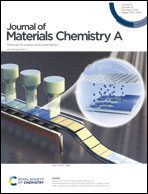Adsorption site engineering: Cu–Ni(OH)2 sheets for efficient hydrogen evolution†
Abstract
Adsorption behavior determines catalytic efficiency in the hydrogen evolution reaction (HER). Thus, engineering catalytic adsorption sites provides an opportunity to investigate in depth the active areas of catalysts. Herein, we put forward an adsorption site engineering strategy to increase the density and intrinsic properties of adsorption sites in Ni(OH)2 by doping with Cu2+. Benefiting from the Jahn–Teller effect of Cu2+, introducing lattice distortion affords Cu–Ni(OH)2 abundant active sites for intermediate conversion. Furthermore, combining experiments with DFT simulations, the doping of Cu2+ in Ni(OH)2 causes local electron accumulation and modulated d electron state, affording Cu–Ni(OH)2 with preferable adsorption behavior for efficient intermediate conversion. As regards the electrochemical results, the obtained Cu–Ni(OH)2 integrated electrode exhibits appealing catalytic activity toward the HER at an overpotential of 53 mV to drive 10 mA cm−2 along with a low Tafel slope of 51 mV dec−1. Hence, we believe that the adsorption site engineering strategy renders a valuable solution for designing efficient catalysts for use in alkaline HER.



 Please wait while we load your content...
Please wait while we load your content...